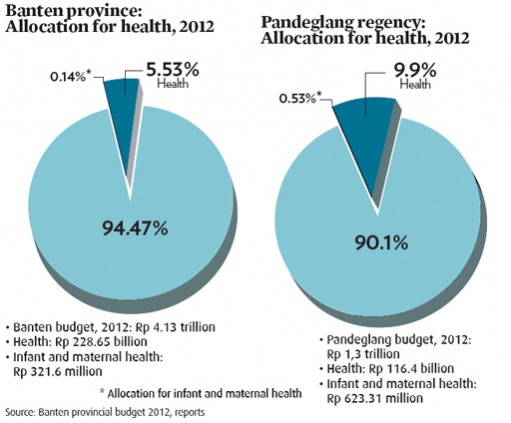 In 1999, decentralization and regional autonomy were introduced in Indonesia to improve public services and increase accountability and transparency in local governance.
In 1999, decentralization and regional autonomy were introduced in Indonesia to improve public services and increase accountability and transparency in local governance.
After over a decade, people living outside the capital, such as in Banten province, still have poor access to health care and education, for instance, despite huge budgetary allocations from the central government to develop local revenue.
Banten is one of 20 provinces with high infant and maternal deaths, according to the Health Ministry. It has been ranked as “average” by the National Development Planning Agency’s (Bappenas) 2012 Human Development Index, which measures progress on health, education and income in 33 provinces. Banten scored a progress rate of 5.85 percent, compared to the national average of 6.25 percent.
Quality healthcare services remain a luxury in many parts of Banten — only a few hours drive west of Jakarta — while the government has increased regional transfer funds each year.
“Such an increase aims to avoid disproportionate allocation of expenditures and revenue between the central and local governments,” said Anton Tarigan, head of local government institutional affairs at Bappenas.
“This also aims to ensure that revenue matches expenditure for different regions.”
According to Bappenas, fiscal transfers to local governments to reduce national and regional fiscal imbalances known as dana perimbangan, made up a majority of local revenues, or an average of 74.15 percent of provincial budgets from 2007 to 2012.
At the provincial level, regional revenue accounted for 36.1 percent of total provincial budgets in 2012, while in regencies and municipalities, local revenue accounted for only an average of 7.6 percent.
“This shows that local administrations are still highly dependent on the fiscal transfers from the central government,” said Anton. The transfer of funds to regions also increased by 15.7 percent annually during 2010 to 2013, he added.
Public services, particularly in health care, do not reflect the significant increases in budget allocations, as most of spending goes to personnel expenditures — salaries, allowances and welfare.
The independent Pattiro watchdog on state and local budgets says only 0.14 percent of Banten’s budget for health last year was allocated to maternal, newborn and child health. Pandeglang’s health sector was alloted Rp 116.4 billion last year, of which some Rp 620 million went to infant and maternal health. Local health officials say this is far from enough for community health sectors in Pandeglang alone.
Executive director of the Banten chapter of Pattiro, Agus Salim, said the small health budget for areas like Pandeglang was worsened by slow infrastructure development.
“Poor quality of roads hampers people’s access to health care.” Many women in labor have died before reaching clinics.
Across regions, Anton said, “Expenditures for personnel accounted for 40 percent of total spending, and the proportion continued to increase until 2011. It was only in 2012 that we saw a decrease in the proportion of personnel expenditures to total budget spending.”
Corruption and weak budgetary processed have been identified as the major causes of slow progress in improving delivery of public services. On Tuesday, Nov. 12, the Corruption Eradication Commission (KPK) announced that businessman Tubagus Chaeri Wardana, the younger brother of Banten Governor Ratu Atut Chosiyah, was named one of three suspects accused of graft in the procurement of medical equipment for community health centers in South Tangerang — where his wife Airin Rachmi Diany is the mayor. The projects were worth Rp 23 billion, the KPK said, though state losses were yet to be revealed.
Unsettled issues on the distribution of authority between the central and local governments pose another challenge to regional autonomy.
Data from the UN Development Program’s Provincial Governance Strengthening Program (PGSP) shows that local governments get only a third of the state budget, while based on the Law No.32/2004 on Regional Governments, 31 government affairs, including the health care, have been handed over to local administrations.
Though decentralization came into effect in 2001, “until now, two-thirds of local budgetary allocations are still circulating around the central government,” said Faisar Jihadi, a regional planning analyst at the PGSP.
Faisar said different priorities between the central and local governments and unsynchronized data had hampered budget allocation to the regions. This has included data on which areas need special financial treatment in overcoming poor nutrition of children — just one example of the barriers to accessing quality health services for mothers and infants.
Such issues must be reviewed, Faisar said, “so that in this era of decentralization and regional autonomy, the government can side more with the local administrations in terms of budget.”




